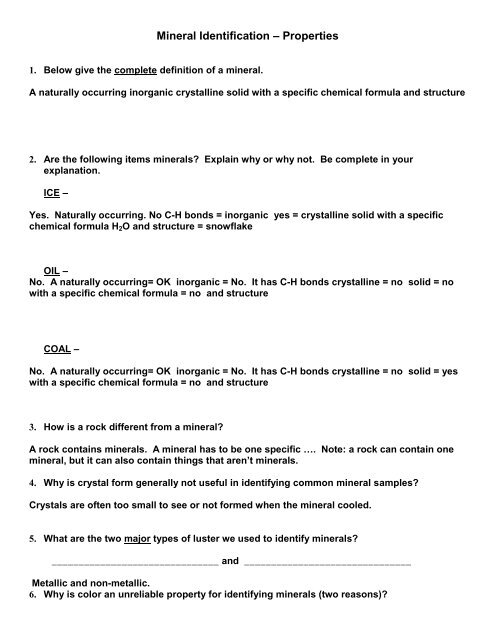Mineral Identification â Properties
Mineral Identification â Properties Mineral Identification â Properties
Mineral Identification – Properties 1. Below give the complete definition of a mineral. A naturally occurring inorganic crystalline solid with a specific chemical formula and structure 2. Are the following items minerals? Explain why or why not. Be complete in your explanation. ICE – Yes. Naturally occurring. No C-H bonds = inorganic yes = crystalline solid with a specific chemical formula H 2 O and structure = snowflake OIL – No. A naturally occurring= OK inorganic = No. It has C-H bonds crystalline = no solid = no with a specific chemical formula = no and structure COAL – No. A naturally occurring= OK inorganic = No. It has C-H bonds crystalline = no solid = yes with a specific chemical formula = no and structure 3. How is a rock different from a mineral? A rock contains minerals. A mineral has to be one specific …. Note: a rock can contain one mineral, but it can also contain things that aren’t minerals. 4. Why is crystal form generally not useful in identifying common mineral samples? Crystals are often too small to see or not formed when the mineral cooled. 5. What are the two major types of luster we used to identify minerals? _______________________________ and _______________________________ Metallic and non-metallic. 6. Why is color an unreliable property for identifying minerals (two reasons)?
- Page 2 and 3: Different minerals can have the sam
<strong>Mineral</strong> <strong>Identification</strong> – <strong>Properties</strong><br />
1. Below give the complete definition of a mineral.<br />
A naturally occurring inorganic crystalline solid with a specific chemical formula and structure<br />
2. Are the following items minerals? Explain why or why not. Be complete in your<br />
explanation.<br />
ICE –<br />
Yes. Naturally occurring. No C-H bonds = inorganic yes = crystalline solid with a specific<br />
chemical formula H 2 O and structure = snowflake<br />
OIL –<br />
No. A naturally occurring= OK inorganic = No. It has C-H bonds crystalline = no solid = no<br />
with a specific chemical formula = no and structure<br />
COAL –<br />
No. A naturally occurring= OK inorganic = No. It has C-H bonds crystalline = no solid = yes<br />
with a specific chemical formula = no and structure<br />
3. How is a rock different from a mineral?<br />
A rock contains minerals. A mineral has to be one specific …. Note: a rock can contain one<br />
mineral, but it can also contain things that aren’t minerals.<br />
4. Why is crystal form generally not useful in identifying common mineral samples?<br />
Crystals are often too small to see or not formed when the mineral cooled.<br />
5. What are the two major types of luster we used to identify minerals?<br />
_______________________________ and _______________________________<br />
Metallic and non-metallic.<br />
6. Why is color an unreliable property for identifying minerals (two reasons)?
Different minerals can have the same color(e.g. fluorite and quartz; pyrite and chalcopyrite;<br />
amphibole and pyroxene, etc.) and the same mineral can have different colors. (e.g. rose<br />
quartz, opal quartz, amethyst quartz, smoky quartz, colorless quartz and blue diamond,<br />
chocolate diamond, canary diamond, colorless diamond)<br />
7. What is the hardness of a mineral that cannot be scratched with your fingernail and does<br />
not scratch glass?<br />
Between 5.5 and 2.5<br />
8. What is the hardness of a mineral if it can be scratched by Fluorite but not by Calcite?<br />
Between 3 and 4<br />
9. Define cleavage.<br />
The tendency of a mineral to break along even/ weak planes.<br />
10. Do all minerals exhibit cleavage? _________<br />
No. Some have fracture.<br />
11. Describe the cleavage of mica.<br />
One perfect direction.<br />
12. Quartz does not exhibit cleavage but it does have a unique type of fracture. Name and<br />
describe the type of fracture exhibited by quartz.<br />
Conchoidal Fracture. It scoops out and has sharp edges.<br />
13. Explain two properties of quartz that have been very important in human history.<br />
Conchoidal fracture, chemical resistance, triboluminescence, and resonance<br />
14. Specific gravity is generally used as a property of minerals. Specific gravity is the ratio of<br />
the weight of a mineral to the weight of an equal volume of water. Specific gravity is<br />
closely related to density. Without giving specific mineral names, what type of minerals<br />
tend to have high specific gravity?<br />
Metals
15. Name two minerals that have high specific gravity.<br />
_______________________________ and _____________________________<br />
Galena, magnetite, hematite, sphalerite,<br />
15. What mineral has a salty taste? ______________________<br />
Halite<br />
16. What mineral exhibits double refraction in clear samples? ______________________<br />
Calcite<br />
17. What mineral feels soapy? _________________________<br />
Talc<br />
18. What mineral feels greasy? ________________________<br />
Graphite or halite<br />
19. What mineral is strongly magnetic?_________________________<br />
Magnatite<br />
20. What specific mineral reacts vigorously with hydrochloric acid?_____________________<br />
Calcite<br />
20. If both samples were slightly magnetic, how could someone conclusively distinguish<br />
hematite from magnetite?<br />
The hardness (magnetite scratches glass hematite doesn’t) or the streak.



